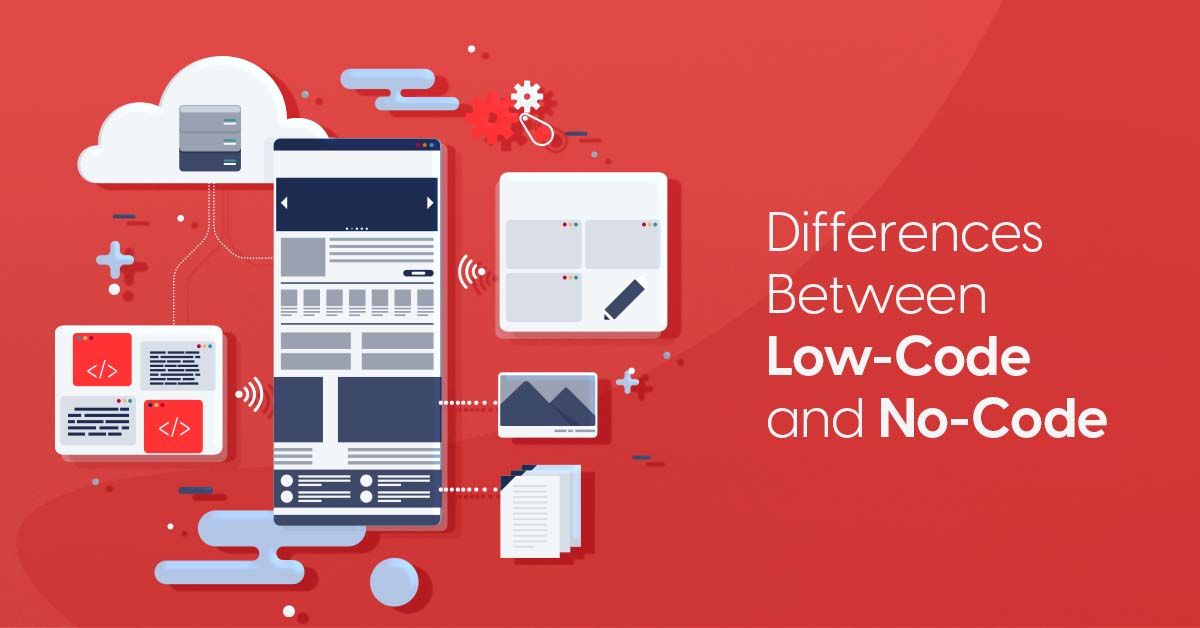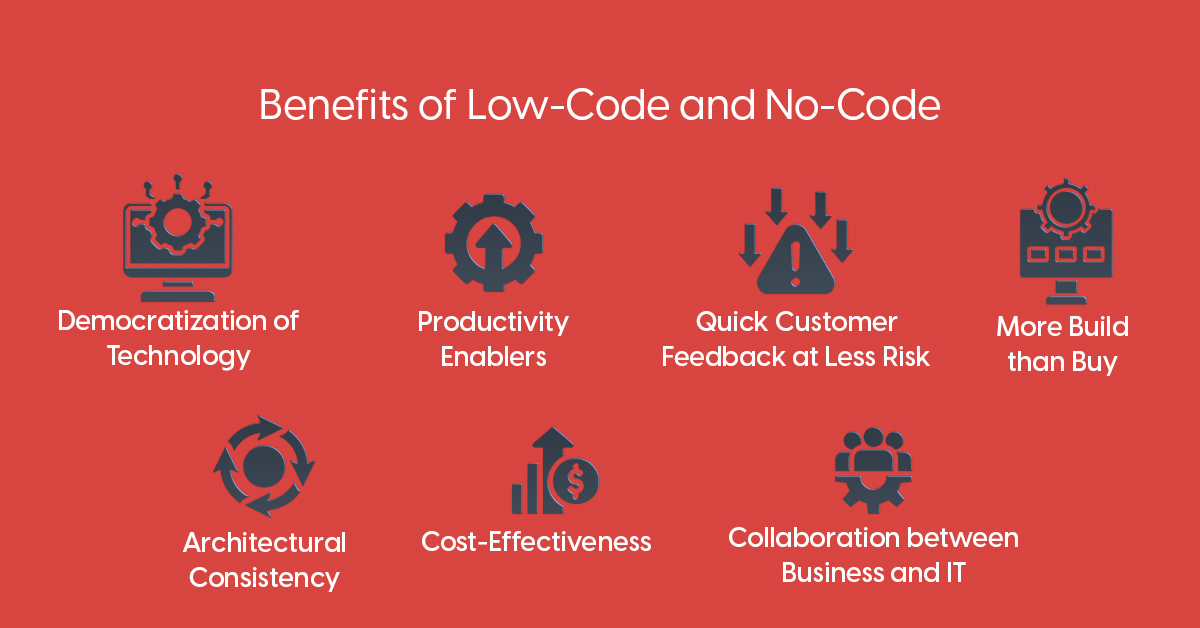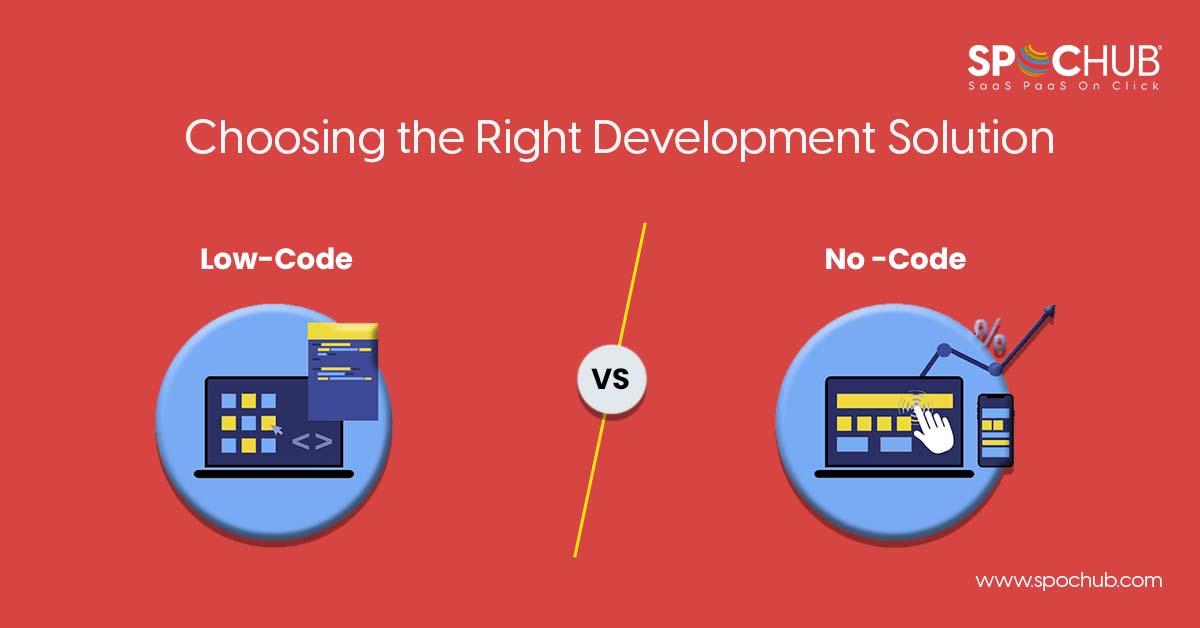In today’s digital first world, the demand for hyper-automation and IT modernization has skyrocketed. However, many enterprises struggle to keep up with these trends due to a shortage of developer talent. As a result, IT projects often get delayed or put on hold, leading to operational inefficiencies and compromised time-to-market. To address these challenges, low-code, and no-code software development solutions have emerged as viable alternatives to traditional development processes.
Here are Some Interesting Statistics about Low Code No Code
- A no-code or low-code platform helps reduce app development time by 90%.
- By 2025, 70% of new business applications will use low-code/no-code technologies.
- In 2021, the low-code platform market is expected to be worth $7.61 billion. By 2027, it is expected to reach $36.43 billion.
- In 2024, 80% of non-IT professionals will develop IT products and services, with over 65% using low-code/no-code tools.
- A no-code solution consumes 70% less resources than traditional app-building platforms.
- About 85% of workers find no-code tools beneficial for their personal and professional lives.
- No-Code Tools are roughly 10 times faster than traditional app development platforms.
- Employing low-code solutions could reduce enterprise app development time by up to 60%.
- Companies using low-code platforms for customer apps see an average revenue increase of 58%.
- Organizations opting for low-code development outpace traditional methods by 56% in solution completion speed.
- A notable 80% of businesses believe low-code solutions can free up developers for essential projects.
What is Low-Code Development?
Low code is a rapid application development (RAD) approach that enables automated code generation through visual building blocks such as drag-and-drop and pull-down menu interfaces. This automation allows low-code users to focus on the unique aspects of their application rather than spending time on common programming tasks. It strikes a balance between manual coding and no-code development, as users can still add code on top of the auto-generated code.
Low-code development finds applications in various areas, including business process management platforms, website and mobile app development, cross-department tools like appraisal management software, integration with external plugins, and cloud-based next-gen technologies such as machine learning libraries, robotic process automation, and legacy app modernization.
Checkout our Web stories – Low-Code vs. No-Code: What’s the Difference?
What is No-Code Development?
No-code development is another RAD approach that often operates as a subset of modular plug-and-play low-code development. While low-code may involve some scripting or manual coding, no-code takes an entirely hands-off approach, relying 100% on visual tools.
No-code development suits applications like self-service apps for business users, dashboards, mobile and web apps, content management platforms, and data pipeline builders. It excels in quickly building standalone apps, straightforward user interfaces, and simple automation. No-code is commonly used in calendar planning tools, facility management tools, and BI reporting apps with configurable columns and filters.

Differences Between Low-Code and No-Code: Low Code v/s No Code
While low-code and no-code solutions share many similarities, there are important differences to consider when choosing between them:
1. Target Users
Low-code development primarily targets professional developers who can leverage the platform to automate standard coding tasks and focus on more complex aspects of development. On the other hand, no-code solutions are aimed at business users with limited or no coding skills, allowing them to build applications without manual coding.
2. Use Cases
No-code development excels in quickly designing front-end apps using drag-and-drop interfaces. It is suitable for UI apps that pull data from various sources, as well as for replacing monotonous administrative tasks performed by business teams. Low-code, with its extensive component library, can handle applications with heavyweight business logic, integration with external APIs, and complex security requirements.
3. Speed
Low-code development may require more training and time to onboard, develop, and deploy due to its customization capabilities. However, it is still considerably faster than traditional manual development. No-code development, being highly configurable and plug-and-play, allows for rapid application building and reduces testing time by minimizing the risk of potential errors introduced by manual coding.
4. Open vs. Closed Systems
Low-code platforms are typically open systems, allowing users to extend functionality through custom code. This provides more flexibility and reusability, but it also requires thorough testing when new upgrades or patches are introduced. No-code platforms, on the other hand, are more closed systems and can only be extended through templated feature sets. While this limits the range of use cases, it ensures backward compatibility and reduces the risk of breaking future versions of the platform.
5. Shadow IT Risk
Both low-code and no-code development present some level of shadow IT risk. However, the risk is higher with no-code solutions, as they require minimal intervention from IT teams. This can lead to the creation of parallel infrastructures that are not closely monitored, resulting in security vulnerabilities and technical debt. Low-code solutions, being under the purview of IT teams, offer better governance and control.
6. Architectural Range
Low-code solutions have a broader architectural range and can support scalability and cross-platform compatibility. With the ability to add custom plugins and code, low-code platforms can be extended to work with multiple platforms and integrate with legacy systems. No-code solutions, on the other hand, have limited extensibility and are more suitable for narrow use cases that don’t require extensive integrations or scalability.
Checkout our Web stories – The Rise of Low-Code/No-Code Solutions
Similarities and Benefits of Low-Code and No-Code Development

Both low-code and no-code development platforms offer several similarities and benefits due to their common approach of abstracting complex coding tasks through visual interfaces and pre-configured templates. Let’s explore some of these similarities and benefits:
1. Democratization of Technology
Both low-code and no-code solutions aim to empower different types of users, reducing dependency on specialized technical skills. This democratization of technology allows businesses to overcome the shortage of skilled developers and opens up opportunities for non-technical users to participate in the development process.
2. Productivity Enablers
Low-code and no-code development platforms accelerate the development process, reducing project timelines from months to days. This increased velocity of development clears IT backlogs and facilitates faster product rollouts, ultimately enhancing overall productivity.
3. Quick Customer Feedback at Less Risk
Low-code and no-code platforms allow developers to gather feedback from customers early in the development process. By showcasing easy-to-build prototypes, businesses can make informed decisions and minimize the risk of investing significant resources in projects that may not meet customer requirements.
4. More Build than Buy
Commercial-off-the-shelf (COTS) products often come with a one-size-fits-all approach, which may not fully meet business requirements. Low-code and no-code platforms incentivize in-house customization, shifting the balance towards building applications tailored to specific needs rather than purchasing off-the-shelf solutions.
5. Architectural Consistency
Low-code and no-code platforms promote architectural consistency by providing reusable components and predefined templates. This consistency is beneficial not only for maintaining code quality but also for debugging applications, as developers can spend more time troubleshooting issues rather than understanding complex frameworks.
6. Cost-Effectiveness
Low-code and no-code development can be more cost-effective than manual development from scratch. These platforms require smaller teams, fewer resources, and have lower infrastructure and maintenance costs. The result is better return on investment (ROI) and faster agile releases.
7. Collaboration between Business and IT
Traditionally, business and development teams have had a push-pull relationship. However, the rise of low-code and no-code platforms has fostered better collaboration and understanding between these seemingly different worlds. Business users can actively participate in the development process, leading to better alignment and improved outcomes.
Use Cases of Low Code No Code Development
Minimum Viable Products: One common use case of low code and no code development is the creation of Minimum Viable Products (MVPs). These are basic versions of a product or application that can be quickly developed and tested in the market. Low code platforms allow businesses to rapidly build and deploy MVPs without the need for extensive coding knowledge, saving time and resources.
Adaptability to New Platforms: Another use case is the development of applications on new platforms. With low code and no code tools, developers can easily adapt their apps to different operating systems and devices. This flexibility enables businesses to reach a wider audience and maximize their market potential.
Smart Process Apps: Smart process apps are another area where low code and no code development can be beneficial. These apps automate complex business processes, such as workflow management, data analysis, and customer relationship management. By utilizing low code platforms, organizations can create customized smart process apps that align with their specific needs and improve operational efficiency.
How does low code no code platforms work?
Low code and no code platforms are development tools that allow users without coding skills to create applications or automate workflows. These platforms are designed to minimize the amount of coding required, making it easier for non-technical users to develop or modify apps without the need for IT resources.
No code platforms are accessed through a visual interface, providing a user-friendly experience. They are ideal for non-technical users who need to create or modify apps, as well as automate tasks without relying on IT support. Use cases for no code platforms include HR, finance, and customer support teams.
On the other hand, low code platforms also minimize the need for coding but offer a higher degree of customization and creativity. They provide a collaborative environment for business and IT teams to work together. This allows business teams to make changes and adjustments to the applications without involving IT professionals. Low code platforms can be used for various purposes such as process automation, platform integration, UI design, and API generation.
Both low code and no code platforms utilize intuitive graphical tools and embedded functionalities to simplify the application development process. These tools eliminate the traditional need for extensive coding knowledge, allowing users to focus on designing and building their applications.
Choosing Between Low-Code and No-Code
When deciding between low-code and no-code development, it’s important to consider the specific requirements of your project. Here are some questions to help you make an informed decision:
1. What are the goals of your development project?
2. Who will be the primary users of the application, and what is their programming expertise?
3. What is the scope and scale of the problem you are trying to solve?
4. Does your application require custom integrations with external or internal systems?
5. What is the desired turnaround time for development and deployment?
6. How much control do you want to retain over the code?
7. Does your application handle confidential data or require stringent security considerations?
By assessing these factors, you can determine whether low-code or no-code development is more suitable for your needs. Remember, it’s essential to take a goal-centric approach rather than focusing solely on the technical expertise of potential users.
Low-Code and No-Code with SPOCHUB
SPOCHUB offer low-code and no-code development solutions that empower users to automate processes and build applications without extensive coding knowledge. By leveraging these low-code and no-code solutions from SPOCHUB, businesses can accelerate their development processes, improve productivity, and drive innovation.
Conclusion
As the demand for software development continues to rise, low-code and no-code solutions have emerged as convenient alternatives to traditional development processes. Both approaches offer benefits such as the democratization of technology, increased productivity, and quick customer feedback. However, they differ in terms of target users, use cases, speed, system openness, shadow IT risk, and architectural range.
When choosing between low-code and no-code development, it’s crucial to consider your specific project requirements and goals. SPOCHUB provides a range of low-code and no-code solutions that empower users to automate processes and build applications efficiently. By leveraging these solutions, businesses can stay ahead in the digital era and drive innovation without being limited by a shortage of developer talent.


